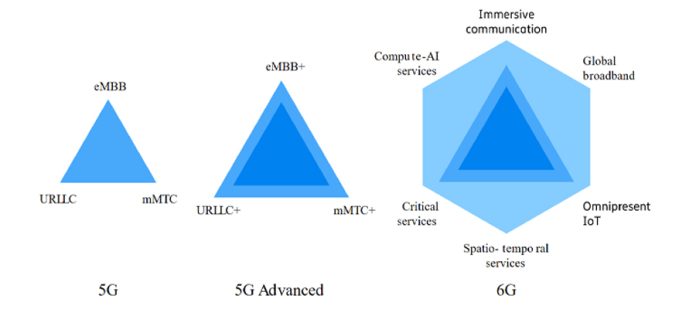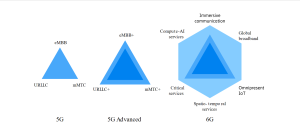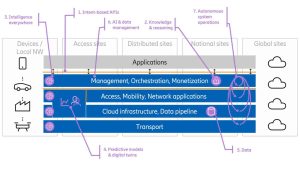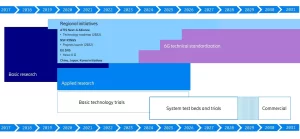6G research is advancing rapidly and already in the applied phase. With standards work set to begin in 2025, our experts summarize the most important takeaways from early 6G research across industries, academia and all parts of the world.
Designing a new generation mobile system is a very complicated engineering task involving thousands of researchers and developers. Their creativity comes up with novel concepts and they work on designing, testing, agreeing upon and building a truly best-in-class end-to-end cellular system. There really is nothing like it.
Today, although we’re at the beginning of this journey with 6G, the volume and breadth of research activity has already been substantial. Basic research concepts underlying 6G are well understood, and concrete 6G technology roadmaps have been proposed by leading collaborations such as the European Hexa-X project, the North American Next G Alliance (NGA), the Chinese IMT-2030 (6G) Promotion Group. And of course, the road to 6G will change over time as 5G evolves and 6G standards work begins.
We already see the emergence of several promising 6G technology concepts across different vendors, industries, and regions. While the exact technical specifications will be a matter for standardization in 2025 and beyond, we can at least say one thing: by enabling and delivering wireless cyber-physical services, 6G will radically alter the world as we see and experience it.
Figure: Above: The high-level view of Ericsson’s 6G vision
But does the wider ecosystem agree? We reviewed various seminal 6G white papers across wireless industries, regional research partnerships and academia to give you the nine key takeaways from the 6G early research phase. As it turns out, these ecosystem takeaways concur very well with our own research outlook towards 6G.
- Sustainability goals will be crucial to 6G use case development
Sustainability is of utmost importance for all sectors of society, and wireless networks already play an important role in achieving UN SDGs and other climate action goals. With 6G, Ericsson believes there is clear potential to further accelerate the value of wireless networks in ensuring digital inclusion on a global scale, enabling access to high-end services for socially important institutions such as schools and hospitals, enabling better resource efficiency such as through global end-to-end digital-asset tracking, and supporting new more environmentally friendly ways of living, working, traveling and more through digitalization.
We also believe that ensuring high network energy performance will continue as a critical design factor in future network platforms, reducing node energy usage to close to zero when not carrying traffic and improving scalability with load adapting to rapid traffic variations.
The University of Oulu’s 6G Flagship project, one of the earliest 6G research projects, compares the shift in focus like going from “5G engineering” to “6G humanity”, and cite an aging population and growing urbanization as some of the challenges which 6G should look to address.
The NGA believes that 6G applications will offer key societal and economic value in achieving high-level goals, for example improving cost efficiency, affordability, access, and societal sustainability when it comes to digital equity. While the European Hexa-X project identifies global service coverage as one example how 6G can contribute to the transformation of society, providing global access to digital services and energy-optimized infrastructures and services.
- 6G will deliver extreme performance
Through immersive communication, 6G will deliver a full telepresence experience, removing distance as a barrier to interaction. To support this and other highly advanced use cases such as remote autonomous robotics, 6G will need to deliver extreme levels of radio access performance in an adaptable fashion – i.e., depending on situational requirements – to a high number of users across a global and pervasive coverage span.
Most stakeholders agree that this will be characterized by an ability to provide high data rates, massive throughput, extremely low latency, seamless multi-access service continuity and ubiquitous connectivity delivered across land, sea and air using terrestrial and non-terrestrial networks.
There is a consensus across the ecosystem that 6G’s extreme performance will also be derived from a combination of factors, including new spectrum bands and the evolution toward new radio technologies including holographic beamforming, advanced duplexing technologies and advanced (also called ‘gigantic’) massive MIMO technology which the NGA regards as a key enabler of 6G’s fast data rates and wide coverage. Nokia Bell Labs suggests that, in the 6G era, multi-user MIMO could be widely applied in mmWave bands to enable massive-scale, multi-user massive MIMO to exploit the available spectrum and manage network density.
At Ericsson, we believe that spectrum in the sub-1 GHz frequency bands will remain necessary even in the 6G era, while mid-band spectrum will continue to address wide area use cases that require capacity. Spectrum in the mmWave range will continue to provide high capacity in crowded environments. New spectrum in the centimetric (7-15 GHz) will be essential to enabling mobile high capacity 6G use cases, while a complementary sub-THz (92-300 GHz) range will help to deliver required speeds beyond 100Gbps and extremely low latencies of 6G niche use cases.
- 6G networks will offer sensing capabilities
Leading network vendors agree that accurate spatial mapping through detailed sensing and high-precision positioning technologies will serve as one of the key pillars of the future 6G system.
This essentially means that 6G networks will be designed with the integrated capability to gain accurate spatial knowledge of physical surroundings, such as through radar-like technologies and other interesting research areas. Sensing can be achieved by observing the characteristics of received signals already present for the communication or using the communication equipment to send additional signals and observe their reflections on objects.
At Ericsson, we believe that reusing cellular systems for sensing can result in both a more cost-efficient sensing system and broader coverage than what can be provided by dedicated sensing systems.
Achieving fully immersive sensing and joint communication in the networks will require significant technology advances in many areas. For example, Nokia Bell Labs identify a need to advance technologies such as AI/ML, and new software and knowledge systems to be able to interpret what the networks see, feed the information into digital twins, and enable wireless industries to build the applications and services that will act upon that data.
- 6G will support trillions of embeddable devices
Digital twins and applications like smart cities will not only benefit from 6G’s spatial mapping technologies, it also requires input from a large number of embedded sensors as well as the possibility to send information to actuators. 6G will therefore support trillions of embeddable devices with trustworthy connections that are available all the time. Low-cost deployment and energy supply to these devices are two of many aspects that are important to address.
- Network resilience will be a key design element of 6G systems
As a key component of future societies, ensuring a continued high level of network reliability, availability, and resilience (NRAR) will remain a key design element of future network evolution. This will be necessary to ensure service continuation against a potential rise of natural disasters, local disturbances, societal breakdowns, and malicious attacks.
At Ericsson, we believe that network resilience will need to be addressed from multiple perspectives. Ensuring the development of a distributed architecture, for example, will be key in ensuring that not all information (and risk) is centralized among a few parties.
Hexa-X agrees that it is important to allow regional network portions to continue operation even when central functions may fail and would be key to ensuring service continuation of critical use cases e.g., emergency health care.
As the demand for potentially life-critical connectivity increases, Nokia Bell Labs believes that the development of 6G sub-networks could serve to ensure high data rates, extreme low latency, and high reliability, where 6G security and resilience features can be enforced to the lowest level of devices in the sub-network.
Then there is the high impact of AI and real-time analytics which will also play a prominent role in ensuring 6G system resilience against dynamic changes in traffic load and radio environments. For example, automated recovery mechanisms can be implemented by analyzing and aggregating data through a distributed and hierarchical approach, ensuring improved observability of performance and real-time requirement validation of services and applications.
- 6G network architecture will be more adaptable and dynamic
As we move toward the 6G era, networks will need to become more adaptable and dynamic to address expected future challenges in areas of deployment costs, energy consumption, network development and expansion, and management and operations.
- 6G networks will have the ability to learn and act autonomously
It will not be possible to enable and support the expected scale and versatility of 6G services without new levels of network intelligence and autonomy. This paradigm shift will take place gradually over the coming years, resulting in 6G networks that are fully cognitive with the ability to observe, reason, acquire new knowledge, and act autonomously. Such cognitive networks will also be crucial in enabling energy efficiencies, optimal performance, and high service availability.
At Ericsson, we believe that the key enablers for this evolution will be data-driven operations, distributed intelligence, continuous learning, intent-based automation, and explainable and trustworthy AI – and will be required to work in synergy across different aspects of functional architecture, deployment scenarios and responsibility areas of different vendors and communication service providers.
Above: Functional architecture view of future cognitive systems
Cognitive networks, together with a transition to data-driven network and service operations, will enable a high degree of automation, performance, efficiency, and insight. For communication service providers, this will inevitably have a significant positive impact on operating- (OPEX) and capital (CAPEX) expenditure, as well as average revenue per user (ARPU) and overall net promoter score (NPS).
There is broad consensus in early 6G research about the key role of AI in 6G systems. Autonomous, cognitive networks require AI capabilities across the end-to-end network architecture to be able to adjust to its environment, and constantly observe and learn from previous actions. AI must therefore be integrated both as a service and a native feature in the 6G system.
Going even further, 6G networks may also provide AI-as-a-service (AIaaS) which can support applications and leverage high-quality data from the ubiquitous generation of raw network intelligence at the edge.
- An integrated network compute fabric will fuel 6G network evolution
Future 6G use cases such as the Internet of Senses and Cyber-Physical Systems will require a new set of capabilities beyond connectivity. Consequently, 6G systems will be designed with the capability to deliver an integrated network compute fabric – transforming the network into a pervasive, globally interconnected compute and storage platform that facilitates optimized handling of application components while giving the impression of locality. – transforming the network into a pervasive, globally interconnected compute and storage platform that facilitates optimized handling of application components while giving the impression of locality.
Real-time infrastructure and services together with unified data access are core elements of the network compute fabric, as well as enabling other key capabilities such as intelligent operations, simplification, and serviceability.
The evolution of the compute and storage paradigm forms a central theme in early 6G research. In their early 6G research, Nokia Bell Labs identify compute as one of the ‘essential dimensions driving the design of the new communications system’.
- 6G will be built to ensure trustworthiness in a new age
The architectural changes foreseen by 6G systems will present a range of new complex and sophisticated cyber security challenges. The threat analysis of future 6G use cases will include new angles such as potential on-body sensors/actuators, extensive AI, and sophisticated 3D+audio content spoofing. In addition, new data privacy- and cryptographic aspects in a new quantum computing era will add further challenges to an already-complex technology area.
Consequently, there has been a lot of focus in early 6G research to ensure the trustworthiness and dependability of future 6G systems, both by strengthening security controls for well-known threats and disruptions, as well as exploring new aspects.
The ability to withstand, detect, respond to, and recover from attacks and unintentional disturbances is a cornerstone in designing trustworthy systems.
At Ericsson, we believe that confidential computing, secure identities and protocols, service availability, and security assurance and defense will continue to be the four crucial building blocks for trustworthy 6G systems and should be further developed in coming years. Confidential computing, for example, has the potential to not only protect the privacy of future cloud users, but also to enhance the security of future network slices through cryptographic isolation.
To address the prospect of more frequent and sophisticated cyber-attacks and security breaches, Hexa-X also identifies the need to develop new and efficient security and privacy schemes, i.e., applying AI to predict problems, detect and automatically resolve attacks that are caused by either classical or AI-based approaches. Another approach identified by Hexa-X includes embedding resilience and security-enabled trustworthiness in both the corresponding software and hardware implementations of future network technologies.
Way forward
Collective efforts to research and define 6G are ongoing and, as you can see in the roadmap below, will continue in the coming years.
Some of the notable activities include ongoing research and industrial projects, such as the second phase of the EU’s Hexa-X project starting now in 2023 with a focus on the systemization of 6G. Parallel to this, there is also ongoing work in the ITU-R with regard to spectrum processes as well as vision and KPI activities.
Ericsson’s view is that 3GPP will begin work on 6G requirements as early as next year, in 2024, with work on technical standardization beginning the following year in 2025. The aim is to have implementable specifications ready by 2028.
A lot of work remains but the coming years will for sure be very interesting!
Above: The roadmap for 6G research, development and standardization












